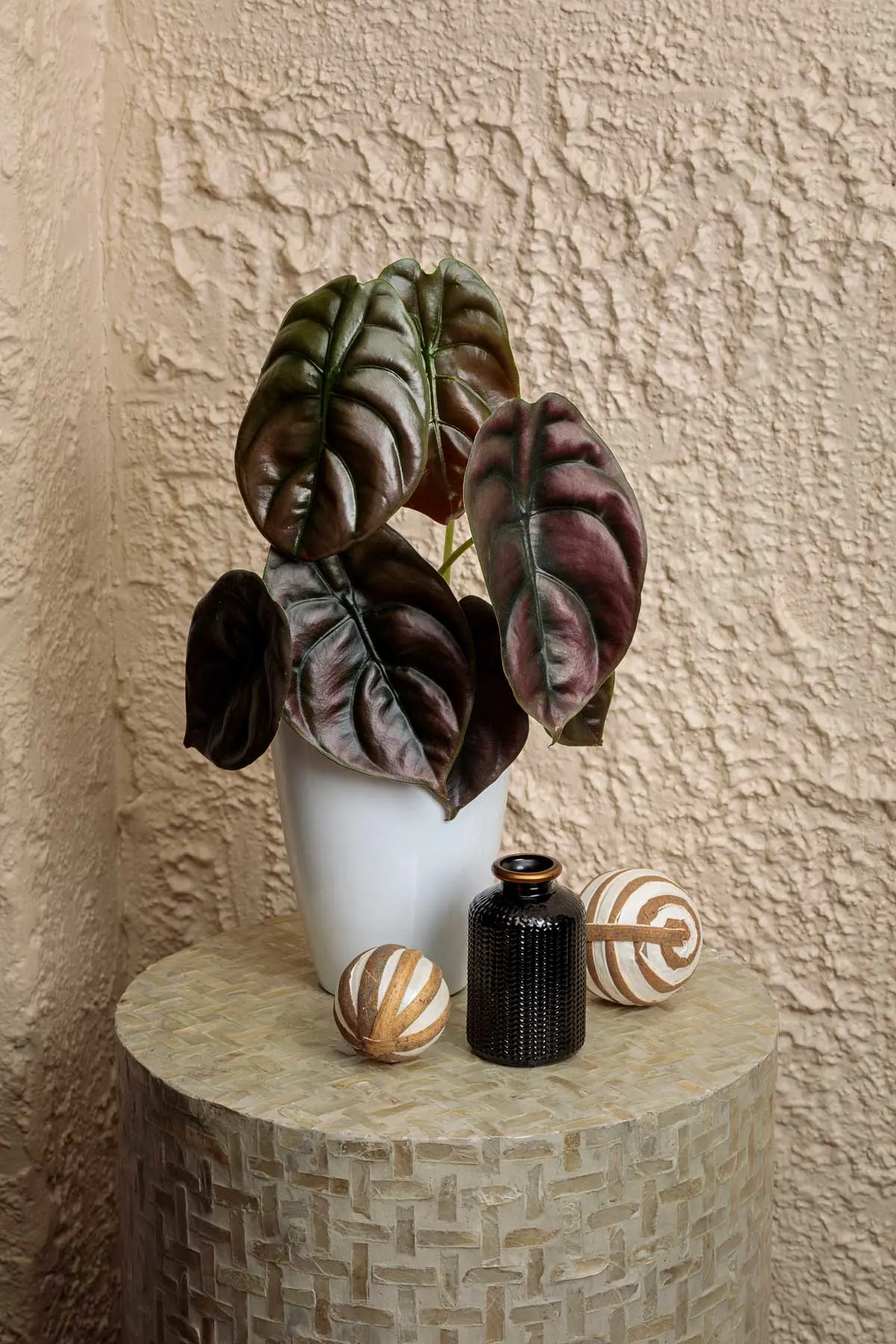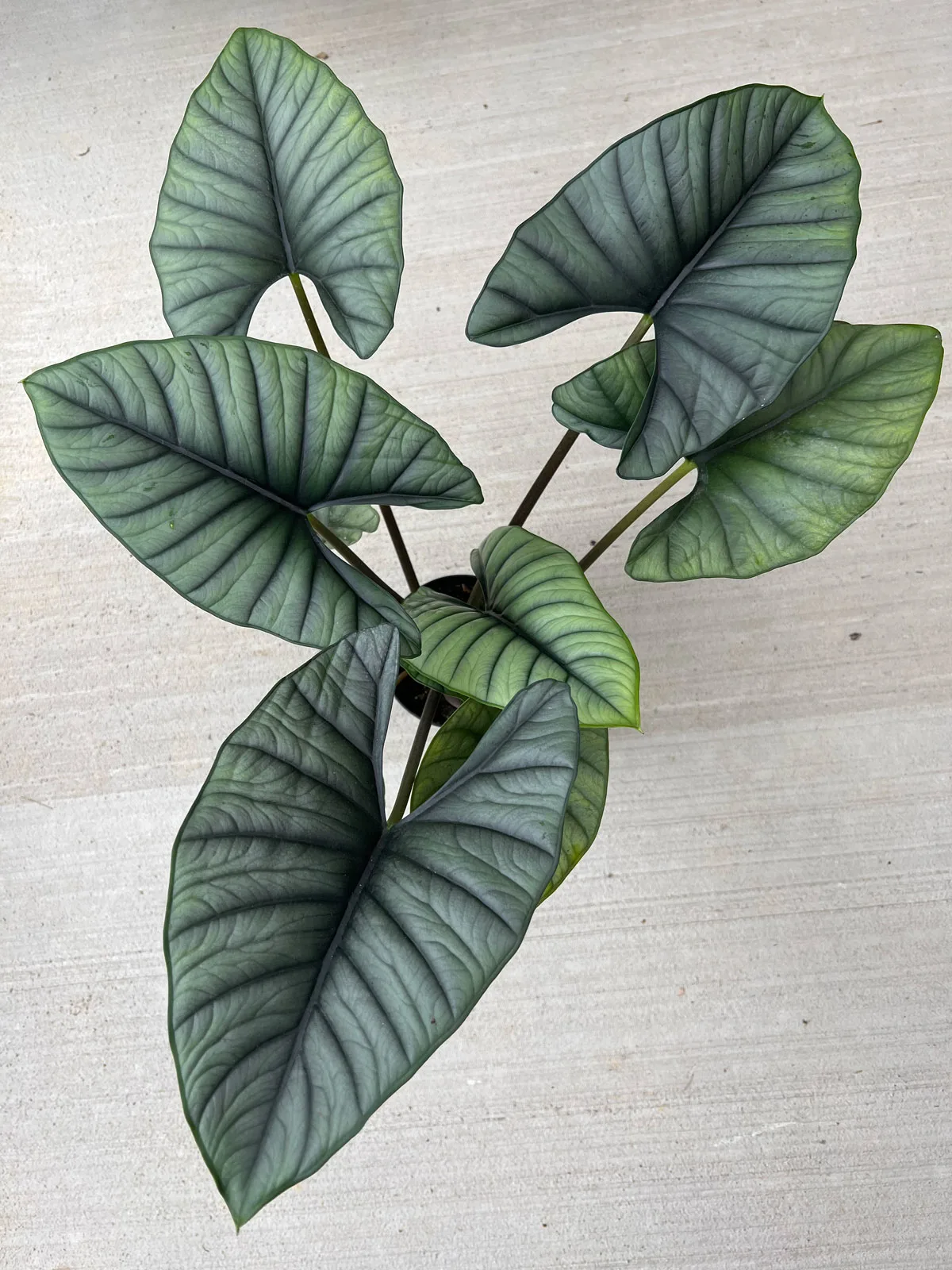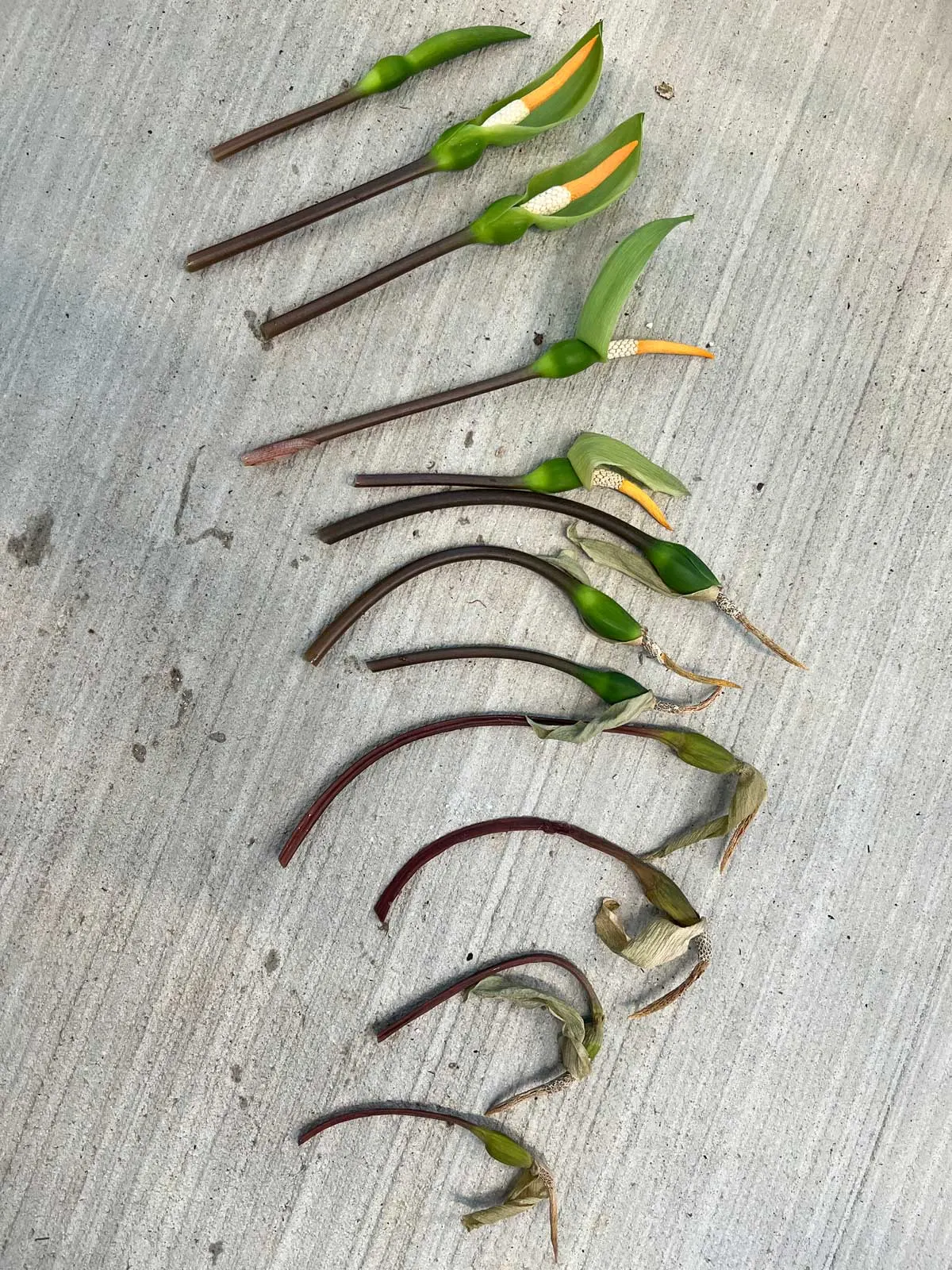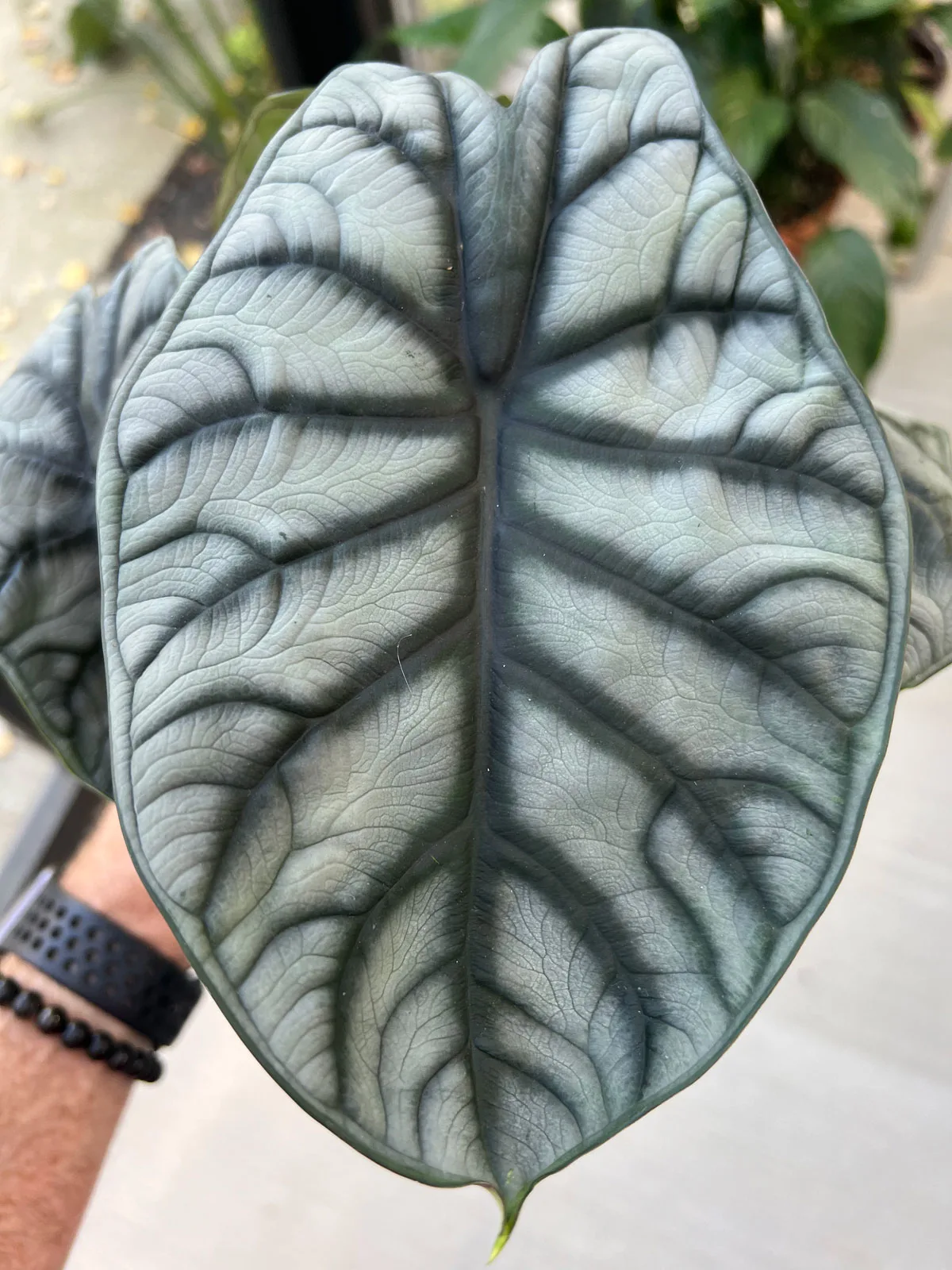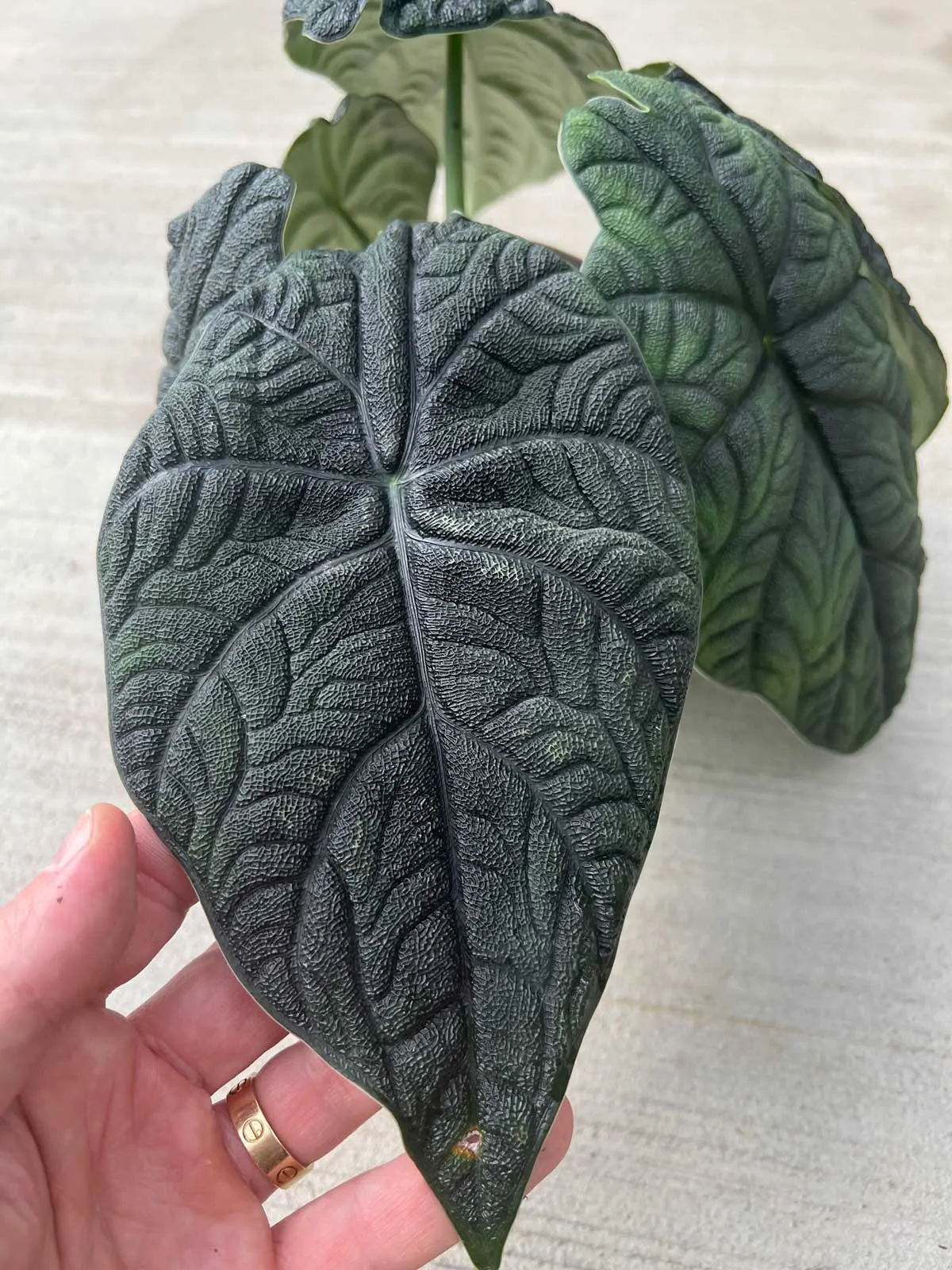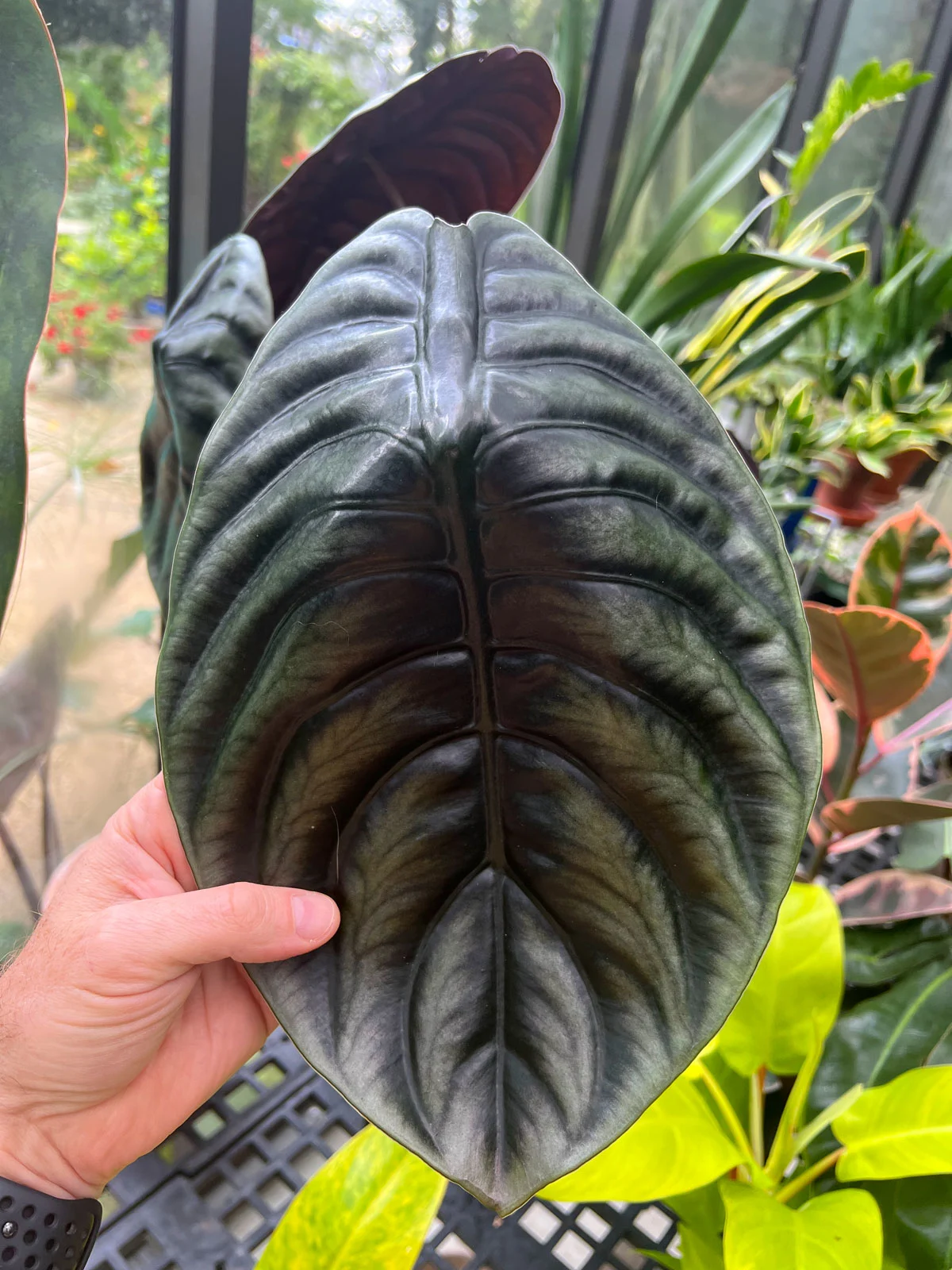Some of the links in this post may be affiliate links.
If you’re looking for a very compact plant that packs a punch, look no further than Alocasia Bambino! This dainty Jewel Alocasia has stunning arrowhead-shaped, dark green leaves which are adorned with lighter veins, making a beautiful statement in your plant collection. Keep reading to learn all the vital care tips for Alocasia Bambino care.
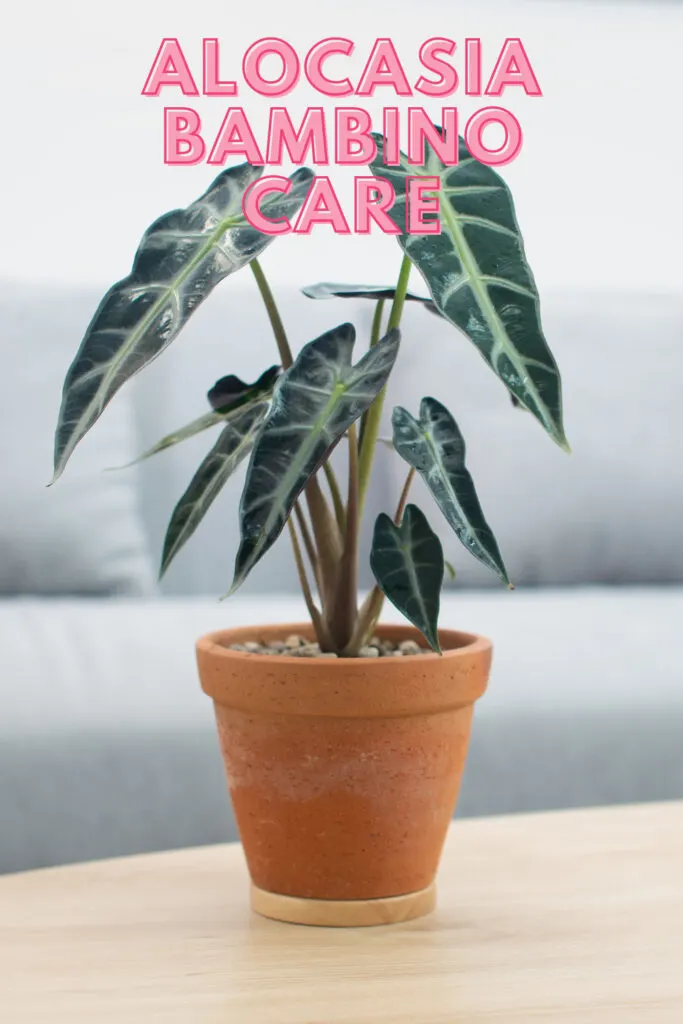
Table of Contents
HOW BIG DOES ALOCASIA BAMBINO GET?
This Jewel Alocasia will typically grow about a foot tall, and no more, making it perfect for smaller spaces! Especially in naturally humid rooms in your home such as bathrooms.
HOW TO CARE FOR ALOCASIA BAMBINO
1. LIGHT
Although Alocasias are often touted as low-light plants, don’t make the mistake of placing this plant in a dark corner of your home.
Indoors, there is already a lot less light than we think, and the majority of the locations in most homes are actually low light.
For best results, place your plant in front of an Eastern or Western facing window. Windows with no direct sun are fine too, but by all means place it immediately in front of those windows.
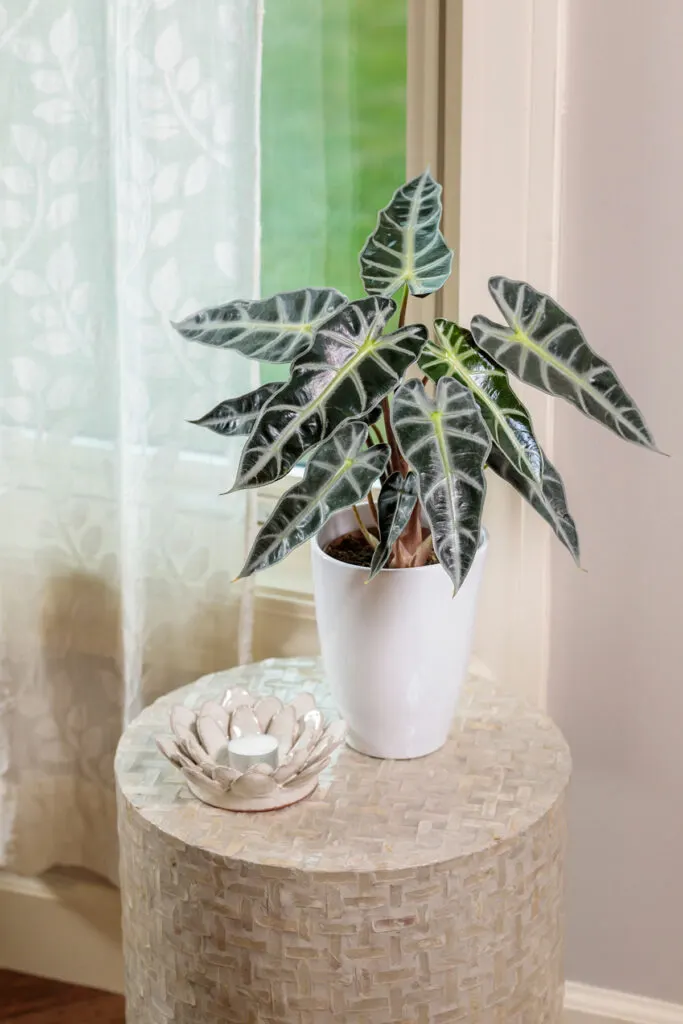
If your home is unusually dark, you can supplement with a good grow light. Grow lights are also helpful for many of us that have short, dark days in the wintertime.
2. WATERING
Water your plant thoroughly until water escapes the drainage hole. After watering, wait until the top inch or so of the potting mix has dried out before watering again.
These plants do not like to go bone dry, so try to avoid that at all cost. If your potting mix dries out too much over an extended period of time, it will start to go dormant. Fortunately, they do come back!
In fact, I’ve allowed one plant to lose all of its leaves once after I had forgotten about the plant, and when I gave it regular water again, it flushed back out with new growth.
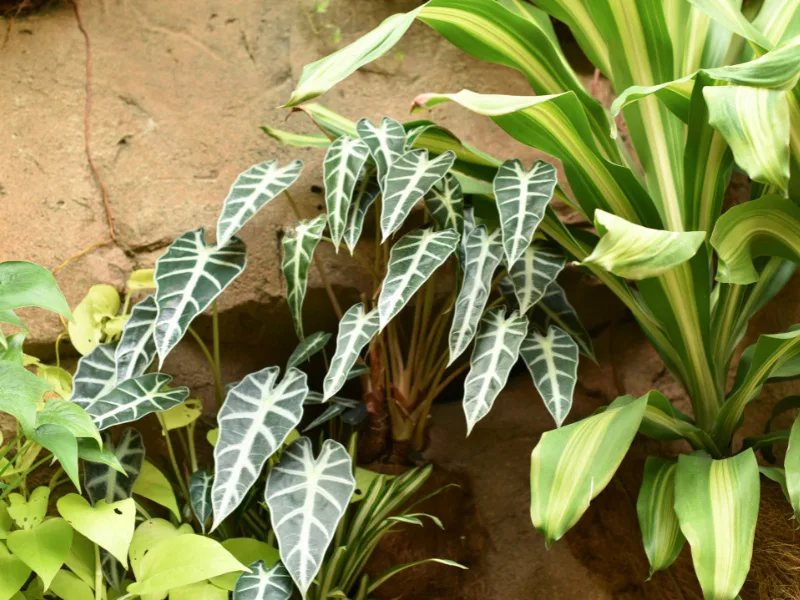
3. FERTILIZER
Regular fertilization while your plant is actively growing is important, and my fertilizer of choice for Alocasias, as well as all of my tropical plants, is Dyna-Gro Grow.
I’ve been using this fertilizer for years, and you will see a wonderful difference with regular use. It contains all the major and micro nutrients that plants need to grow.
It is also urea-free, so the risk of fertilizer burn is greatly diminished. Try Dyna-Gro Grow for yourself and experience the difference it can make!
4. TEMPERATURE
Like any Alocasia, Bambino likes evenly warm conditions. Aim for 65°-85°F (18°-29°C) as an ideal temperature range for your plant.
Avoid cold and hot drafts, such as those coming from heatling/cooling vents, and keep away from doors and windows during cold weather.
Bambino will appreciate an evenly warm, stable temperature.
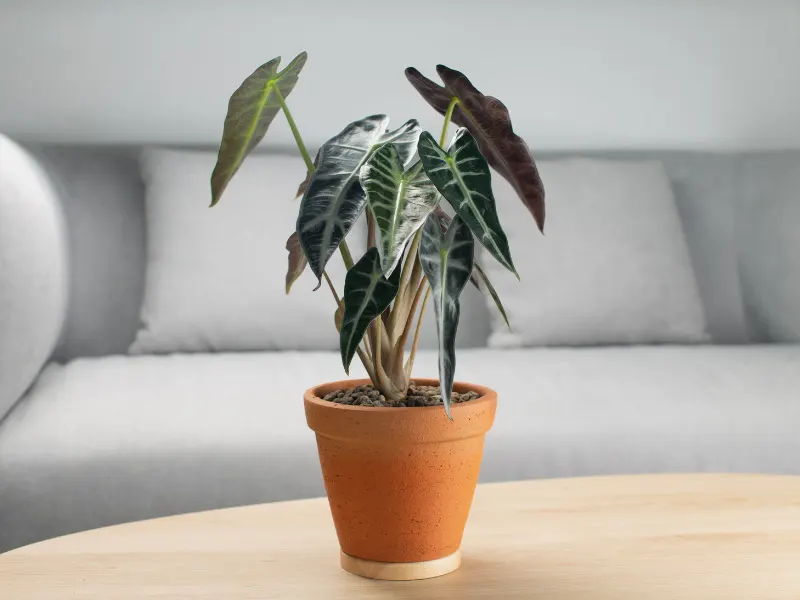
5. HUMIDITY
They can tolerate average humidity, but will definitely appreciate it if you can increase humidity.
Remember that misting does NOT
Not only is it good for your plants, but it’s also good for your nasal passages and your skin, particularly in the winter if you’re running forced air heat which will make the air painfully dry.
Aim for 50-60% relative humidity if you can.
6. POTTING MIX and POT TYPE
You can use many potting mix types, and many have their own special blends for Alocasias and other aroids.
One classic mix for Alocasias and aroids in general is using equal parts all-purpose potting mix, perlite and orchid bark. Keep in mind that “chunky” potting mixes like this will dry out quickly than mixes that don’t contain as much coarse materials like perlite and orchid bark.
If you want to take the guess work out, try out the Pray For Us blend from Oh Happy Plants.
It has special moisture retentive properties, but is chunky enough that you don’t have to worry about your mix staying too wet! It’s a wonderful, turn-key mix that eliminates all the guess work.
I’ve used Pray For Us on many types of plants including Alocasias, Prayer Plants and more. Read up more on the Pray For Us blend, and you will get 10% off automatically at checkout!
The ingredients are sustainable and I’ve noticed a difference in the health of my plants!
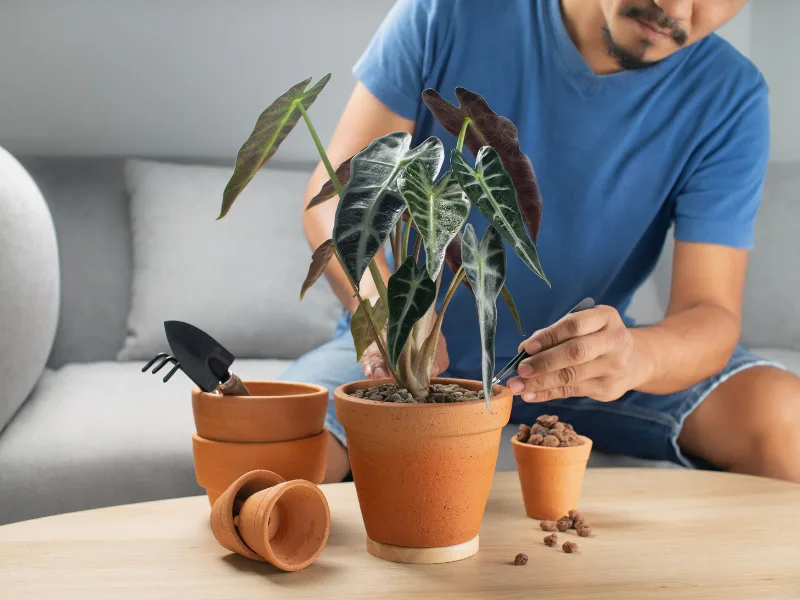
As far as pot types, you can use a variety of types as long as you have drainage holes. Alocasia will rot readily if they sit in water for extended periods of time.
Even terra cotta pots, although it may seem counterintuitive to use for a moisture loving plant, can be used successfully as long as you can keep up with the watering.
You can really encourage a wonderfully healthy root system with terra cotta pots (as a result of their porous nature, allowing more air to the roots).
Experiment with whatever pot type works with your routine.
7. HOW TO PROPAGATE ALOCASIA BAMBINO
Alocasias will propagate themselves by growing more corms. Small plants will form from small corms at the base of the plant.
Don’t be too quick to separate those baby plants though otherwise you can stunt the growth of the plant. I recommend waiting until the baby plants have gotten about half the size of the parent plant before separating them.
A good time to do this is what your plant needs to be repotted. That way you can repot your plant, and separate any new plants off from the mother plant.
FREQUENTLY ASKED QUESTIONS
WHY IS MY ALOCASIA BAMBINO TURNING YELLOW?
Yellow leaves can be caused by a variety of factors. More often than not though, it is typically caused by allowing your potting mix to go too dry.
The only way you’ll know is by feeling the potting mix with your fingers, and even picking up your pot to see if it feels really light. Don’t rely on moisture meters as many are notoriously unreliable.
If you let your Bambino go bone dry, it will start to go dormant. This is a natural process (in nature, many Alocasias have a dry season where they will at least go partially dormant). But you CAN avoid dormancy indoors if you keep up with your watering properly.
Even if you do lose quite a few leaves, your plant will come back with regular watering.
HOW DO I DEAL WITH SPIDER MITES ON MY ALOCASIA BAMBINO?
Alocasia ‘Bambino’ isn’t prone to many pests, but the most common one is probably spider mites. Spider mites are most common in dry, warm air.
You’ll typically see a fine webbing on your leaves, and small mites crawling around. Check out my blog post on dealing with spider mites.
You’ll basically want to rinse your plant off with warm water to knock the population down, and then proceed to use a good spray, such as an
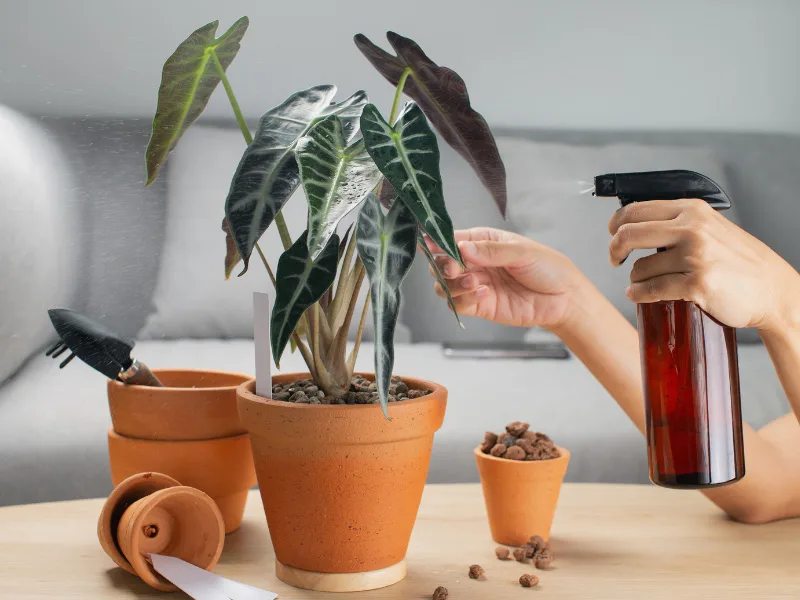
ALOCASIA BAMBINO VS POLLY
Although they look similar, there is an easy way to distinguish a Bambino and a Polly. As you can see from the photo above, the leaves of ‘Bambino’ have smooth edges, and are narrower.
Polly has wavy edges on the leaves and they are also wider.
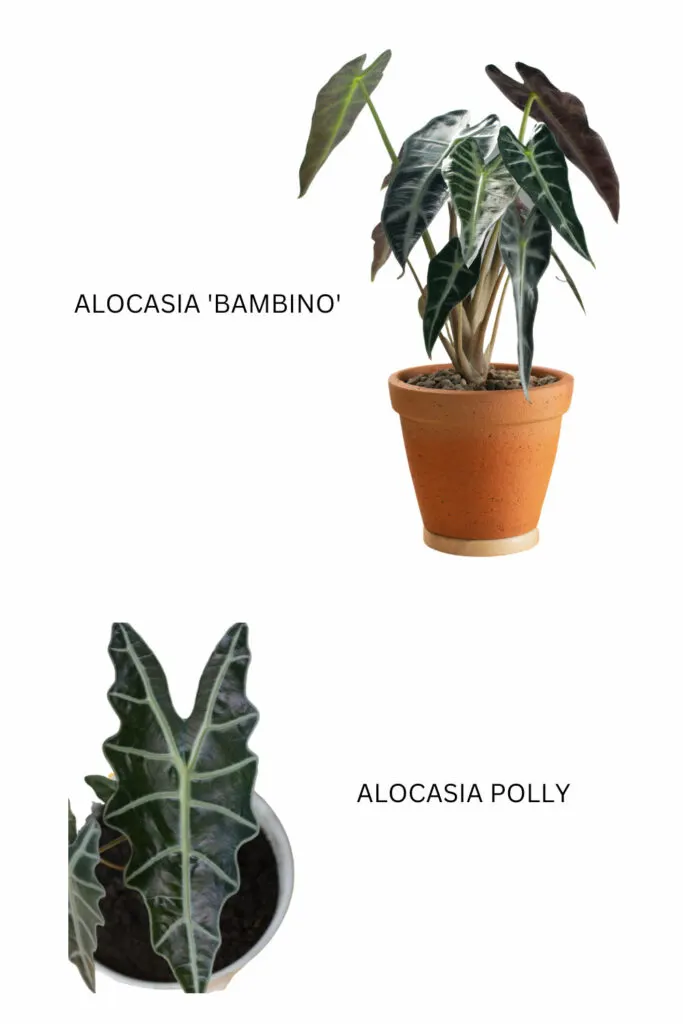
Your Alocasia may also respond with yellow leaves in the winter time if you live in an area with short, dark days in the winter. This is perfectly natural for your plant to respond this way. If you want to avoid this, you can use a grow light to provide supplemental lighting in the winter.
I hope you’ve enjoyed this post on Alocasia Bambino. Check out my blog post on many other Alocasia varieties out there. There are so many gorgeous ones to add to your collection!

